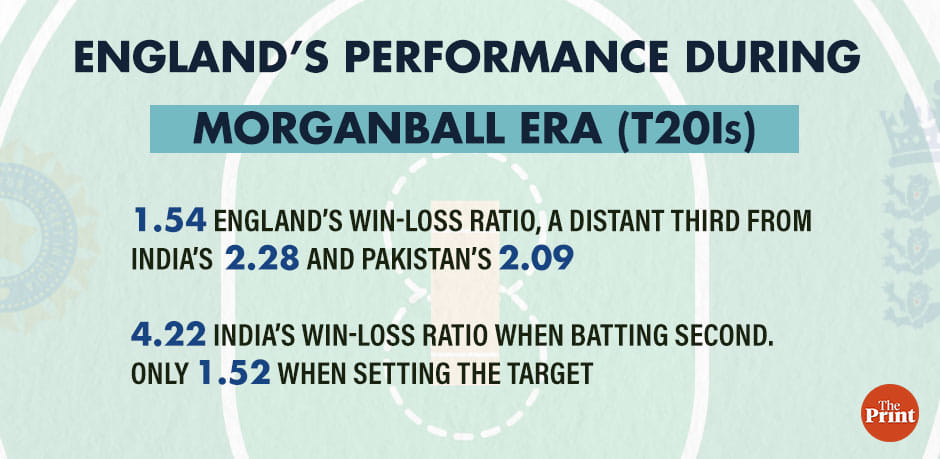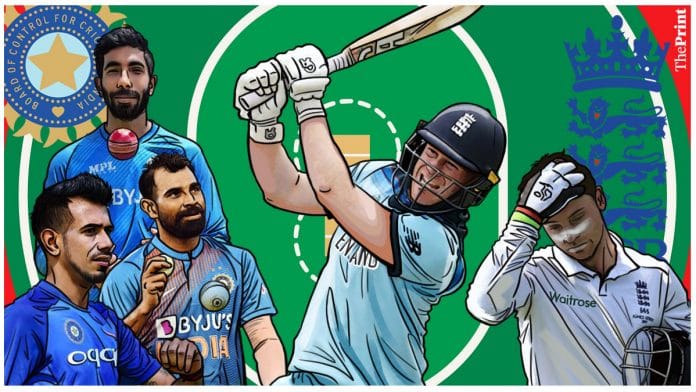Jos Buttler has taken over the captaincy of England’s white-ball cricket team and has found it tough to replicate the success of his predecessor Eoin Morgan. It is still early days, but Buttler’s England are yet to register a tournament victory even as they have played in home conditions. India and South Africa, the visiting teams, have found better results by employing England’s own strategy. Pioneered by Morgan, the strategy—let’s call it ‘Morganball’ —calls for an aggressive approach to batting right from the start. With this strategy, one-day cricket seems more like an extension of T20 cricket.
There are two points to be made here. First, like any strategy, ‘Morganball’ is not a silver bullet. It has its pros and cons. Specifically, it works better for the chasing team than for the team batting first. It is easy to see why this would be the case.
Success of the ‘Morganball’
Playing conditions, like the pitch and weather, may not suit the aggressive style of batting every time. The team batting first does not know the true conditions going into bat. The conventional style—of taking some time to assess the conditions—allows batsmen to adjust to bowling-friendly conditions if they exist. ‘Morganball’ does not afford the players much time. If the conditions turn out to be hostile, you only learn that through losing wickets and you still have to score fast. However, since pitches these days are indistinguishable from expressways, ‘Morganball’ usually works if you have batsmen with the capability to use the long handle. Results show that England not only won the last World Cup in 2019 but has been generally successful in one-day cricket.

Since Morgan took over one-day captaincy permanently from Alastair Cook in early 2015 and until the last match he captained, English batsmen had the highest strike among the nine major teams playing one-day cricket. During this period, between 16 January 2015 and 19 June 2022, English batsmen scored at a strike rate of 98.86, while the next best, Australians, fared much behind at 92.60. England’s win-loss ratio was also the best at 2.07 with New Zealand (1.97) and India (1.87) occupying the second and third positions respectively.
Morgan’s English team, however, performed much better when batting second. Over the same time period, England’s win-loss ratio was 2.71 while chasing but slumped to 1.59 when setting the target. For eight other major cricket-playing countries, the win-loss ratio did not differ much depending on whether they batted first (1.13) or second (1.14). It seems reasonable to conclude that despite vastly improved conditions for batting and a new mindset of playing cricket, ‘Morganball’ as a strategy still carries some risk for teams batting first.
Also Read: MS Dhoni is the rainbow of Indian cricket, a cult figure who inspires youth across nation
Advantages for India
The second point is that if ‘Morganball’ works better for teams chasing, then India might be well suited to reap its advantages.
One can say that Morganball is more of a revolutionary strategy for one-day cricket, not so much in the T20 format. In T20s, the teams are aggressive from the start in any case. It shows in the results too. Though England has performed well, they did not dominate T20 cricket as they did in one-day cricket. England’s win-loss ratio during the period was 1.54, a distant third from India’s 2.28 and Pakistan’s 2.09. India’s success in T20s during this period of supposed ‘Morganball’ dominance also came while chasing. Its win-loss ratio was 4.22 when batting second and only 1.52 when setting the target. India has been employing ‘Morganball’ in T20 cricket and it has proved quite successful—of course, except when playing in the World Cups.

Why does it suit India? Because when one team plays ‘Morganball’, the other team has no option but to do the same. If you know that India will bat aggressively, then the opposition has a lot of pressure to score big when batting first. It is in doing so that the opposition batsmen have to target bowlers of the calibre of Jasprit Bumrah, Mohammed Shami and Yuzvendra Chahal. Bumrah’s economy rate in one-day cricket is 4.63—the second best among all bowlers of nine major cricket-playing countries with 50 or more wickets in the period since Bumrah debuted. Batsmen frustrated with Bumrah’s stinginess have to take extra risk against Shami, who has the sixth-best strike rate among his equivalent competing group of bowlers (according to the criteria defined for Bumrah). Chahal’s strike rate is the best among the equivalent competing group of spinners from nine major countries with 50 or more wickets since he debuted. During the heydays of ‘Morganball’, Indian bowlers conceded only 5.24 runs per over when bowling first in one-day games—the best economy rate among all nine major cricket-playing countries. It was no surprise that Buttler’s England collapsed in all matches of the recent one-day tournament while trying to target Indian bowlers while batting first.
When ‘Morganball’ can be so effective batting second for India, then why can’t the team go with this strategy only when chasing? Because it is not just a strategy that you can execute in one match and drop in another. ‘Morganball’ is about building a reputation by playing consistently in this manner. Only when India bats aggressively and posts big totals while batting first, it can force other teams to take risks when they bat first against Bumrah, Shami and Chahal. The risks and rewards of ‘Morganball’ stand clear.
Kunal Singh is doing a PhD in international security but follows cricket closely, sometimes at the expense of his research work.
(Edited by Srinjoy Dey)






